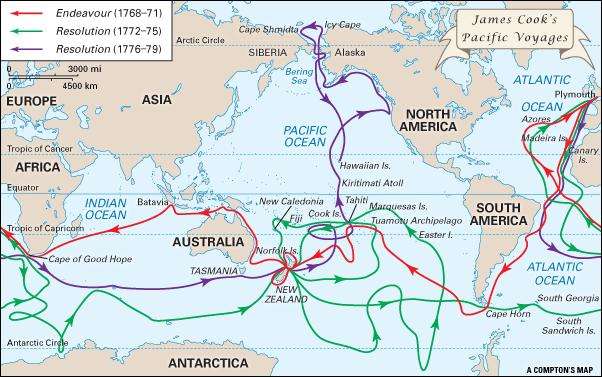 |
| James Cook |
James Cook was born in Marton-in-Cleveland, England, on October 27, 1728. His family was Scottish in origin, having left Scotland for England after the upheaval of the 1715 Jacobite Rebellion.
Cook’s father was a farm worker. When James was seven, his father’s employer arranged for him to attend school, and at the age of 12, he became an apprentice to a shopkeeper in a nearby coastal town.
This first exposure to the sea took hold of the boy, and he left his apprenticeship in 1746 for a new position with shipowners. In his new surroundings, he learned about math, navigation, compasses, and maps.
  |
In 1755 Cook became a mate on one of his employer’s ships. Later that year, Cook left to join the Royal Navy. Because war with France was impending, Cook expected that his experience and skills would be put to good use and result in rapid promotions.
Cook’s first assignment was aboard the Eagle, where he met Hugh Palliser. Palliser would figure largely in Cook’s life as a mentor and advocate. Within a month, Cook had proven his seafaring skills and was put in charge of the ship’s navigation.
In 1757 Cook was again promoted and assigned to the Pembroke on Palliser’s recommendation. Now that Britain was at war with France, Cook’s assignments were related to wartime service.
He spent almost a decade in North America, charting rivers and creating maps of Canada, Nova Scotia, and Newfoundland. During these years, he returned to England once and married Elizabeth Batts in 1762. It was not long before he was back at sea, working on charts and maps of North America.
In 1767 Cook resigned command of his ship and returned to England, but his reputation soon earned him an opportunity to travel to the Pacific Ocean to observe the transit of Venus.
The Royal Society commissioned his service, and upon acceptance Cook was given command of the Endeavour. In addition to the scientific objectives of the mission, Cook was asked to verify or disprove the existence of a large continent in the Pacific Ocean.
Cook and his crew sailed to the Madeira Islands, Canary Islands, Cape Verde Islands, Rio de Janeiro, and then went around Cape Horn into the Pacific Ocean. They reached Tahiti in April 1769, observed and documented the transit of Venus on June 3, and continued their voyage in July.
The Endeavour sailed on to New Zealand, where Cook spent six months working on maps and charts of the islands and the waters. Cook and his crew had their first encounters with the Maori. Although the Maori culture (particularly their ritual cannibalism) was frightening to the English sailors, Cook managed to make cultural and linguistic observations about the Maori people.
   |
In 1770 he took his ship around Australia, which he named New South Wales when he claimed it as the king’s. From there, he went to New Guinea, Java, the Cape of Good Hope, and home to England on June 12, 1771.
As was common, he had lost many of his crewmen—about one-third—to scurvy during the voyage. He had circumnavigated the globe, discovering new geography along the way, and was promoted to the rank of commander.
Cook again set sail on July 13, 1772, aboard the Resolution, accompanied by the Adventure. After going to Africa, the Cape of Good Hope, and the Antarctic Circle, the ships headed for the South Pacific. They returned home in July 1775, having charted new and existing lands. As before, Cook brought back valuable new charts and maps of the globe.
He had made another discovery during this voyage; good nutrition enabled his crew to stay healthy despite the long days at sea and difficult conditions living on a ship. Unlike on his voyage on the Endeavour, Cook lost only one man on the entire trip. For this medical advance, Cook received the Copley Gold Medal from the Royal Society.
Cook’s final voyage came after his promotion to captain, and he and the crew of the Resolution headed for the northern Pacific to seek a passage across North America and to the Atlantic Ocean. Accompanying him was the Discovery, and together the ships set sail on July 12, 1776.
After covering familiar ground (Africa, Cape of Good Hope, New Zealand, Tahiti, and elsewhere), Cook and his crew discovered Hawaii and arrived on the North American coast (where Oregon is today) in February 1778.
His expedition explored the coast all the way up through the Bering Strait without finding the northern passage they hoped to discover. Although the expedition was to continue back into the Pacific after a return to Hawaii, Cook was killed in a conflict with natives in Karakakoa Bay on February 14, 1779.
When he and his men had arrived in Hawaii in January, relations with natives were friendly and safe, but cultural misunderstandings brought changes in the way the crew treated the natives.
Eventually things escalated to the point of a violent skirmish, and Cook was stabbed. The man who stepped up to replace Cook as commander of the voyage negotiated for the return of Cook’s body; the crew gave him a burial at sea on February 21, 1779.
